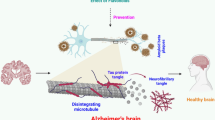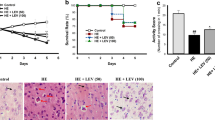Abstract
Neuroinflammation and oxidative stress play an important role in cognition deficit following chronic cerebral hypoperfusion (CCH). Luteolin, a natural flavonoid found in many plants, is known for a variety of pharmacological activities, such as its anti-inflammatory, anti-allergy, urate, anti-tumor, antibacterial, and antiviral effects. To assess whether luteolin could prevent CCH-induced cognitive dysfunction, through its anti-inflammatory and anti-oxidative-stress effects, we used enzyme-linked immunosorbent assays, enzyme activity assays, behavioral methods, immunohistochemistry, and electrophysiology to detect neuroinflammation and oxidative stress, cognition alterations, and long-term potential (LTP), in a bilateral common carotid arteries ligation (2VO) rat model. We demonstrated that CCH increased tumor necrosis factor α (TNF-α), interleukin 1β (IL-1β), interleukin 6 (IL-6), and malondialdehyde (MDA), and decreased superoxide dismutase (SOD) and glutathione peroxidase (GPx) levels. Further, it caused microglia over-activation and astrogliosis, learning and short-term memory dysfunction, and an LTP deficit. Luteolin treatment reversed CCH-induced changes. Specifically, luteolin prevented the increase of TNF-α and IL-1β, IL-6, and MDA, improved the activity of SOD and GPx, inhibited microglia over-activation and astrogliosis (particularly in the hippocampus and cortex), and ameliorated learning and short-term memory dysfunction, and LTP deficit. Thus, our study suggested that luteolin could be a preferable anti-inflammatory agent to protect cognitive function and synaptic plasticity following CCH. Luteolin could also be putative therapeutic candidate for other inflammation-related brain diseases.








Similar content being viewed by others
Abbreviations
- Aβ40 :
-
Amyloid β-protein 40
- AP-1:
-
Activating protein-1
- BBB:
-
Blood–brain barrier
- BSA:
-
Bovine serum albumin
- CCH:
-
Chronic cerebral hypoperfusion
- cDNA:
-
Complementary DNA
- Con:
-
Control group
- COX-2:
-
Cyclooxygenase-2
- DAB:
-
Diaminobenzidine
- ELISA:
-
Enzyme-linked immunosorbent assay
- fEPSPs:
-
Field excitatory postsynaptic potential
- GABA:
-
γ-Aminobutyric acid
- GAPDH:
-
Glyceraldehyde 3-phosphate dehydrogenase
- GFAP:
-
Glial fibrillary acidic protein
- GPx:
-
Glutathione peroxidases
- HRP:
-
Horseradish peroxidase
- HFS:
-
High frequency stimulation
- IBA-1:
-
Ionized calcium-binding adapter molecule 1
- IL-1β:
-
Interleukin 1β
- IL-6:
-
Interleukin 6
- IL-8:
-
Interleukin-8
- LPS:
-
Lipopolysaccharide
- IκB-α:
-
Kappa B-alpha
- iNOS:
-
Inducible nitric oxide synthase
- KA:
-
Kainic acid
- LTP:
-
Long-term potentiation
- Lut:
-
Luteolin treatment
- mAb:
-
Mouse monoclonal antibody
- MAPK:
-
Mitogen-activated protein kinase
- MDA:
-
Malondialdehyde
- MWM:
-
Morris water maze
- NSFC:
-
National Natural Science Foundation of China
- NO:
-
Nitric oxide
- PP:
-
Perforant path
- NOR:
-
Novel object recognition test
- PPF:
-
Paired-pulse facilitation
- qRT-PCR:
-
Quantitative real time polymerase chain reaction
- SDS-PAGE:
-
Sodium dodecyl sulfate polyacrylamide gel electrophoresis
- SOD:
-
Superoxide dismutase
- TNF-α:
-
Tumor necrosis factorα
- TUNEL:
-
Terminal deoxynucleotidyl transferase (TdT)-mediated dUTP nick end labelling
- 2VO:
-
Bilateral common carotid arteries ligation
- 2VO + Lut:
-
2VO operation and luteolin treatment
References
Tang H, Gao Y, Zhang Q, Nie K, Zhu R, Gao L et al (2017) Chronic cerebral hypoperfusion independently exacerbates cognitive impairment within the pathopoiesis of Parkinson’s disease via microvascular pathologys. Behav Brain Res 333:286–294
Choi BR, Lee SR, Han JS, Woo SK, Kim KM, Choi DH et al (2011) Synergistic memory impairment through the interaction of chronic cerebral hypoperfusion and amlyloid toxicity in a rat model. Stroke 42(9):2595–2604
Fernandez-Ruiz A, Oliva A, Nagy GA, Maurer AP, Berenyi A, Buzsaki G (2017) Entorhinal-CA3 dual-input control of spike timing in the hippocampus by theta-gamma coupling. Neuron 93(5):1213–1226.e5
Hase Y, Craggs L, Hase M, Stevenson W, Slade J, Lopez D et al (2017) Effects of environmental enrichment on white matter glial responses in a mouse model of chronic cerebral hypoperfusion. J Neuroinflammation 14(1):81
Wang J, Zhang HY, Tang XC (2010) Huperzine a improves chronic inflammation and cognitive decline in rats with cerebral hypoperfusion. J Neurosci Res 88(4):807–815
Shimoi K, Okada H, Furugori M, Goda T, Takase S, Suzuki M et al (1998) Intestinal absorption of luteolin and luteolin 7-O-beta-glucoside in rats and humans. FEBS Lett 438(3):220–224
Kwon Y (2017) Luteolin as a potential preventive and therapeutic candidate for Alzheimer’s disease. Exp Gerontol 95:39–43
Kotanidou A, Xagorari A, Bagli E, Kitsanta P, Fotsis T, Papapetropoulos A et al (2002) Luteolin reduces lipopolysaccharide-induced lethal toxicity and expression of proinflammatory molecules in mice. Am J Respir Crit Care Med 165(6):818–823
Xagorari A, Papapetropoulos A, Mauromatis A, Economou M, Fotsis T, Roussos C (2001) Luteolin inhibits an endotoxin-stimulated phosphorylation cascade and proinflammatory cytokine production in macrophages. J Pharmacol Exp Ther 296(1):181–187
Nunes C, Almeida L, Barbosa RM, Laranjinha J (2017) Luteolin suppresses the JAK/STAT pathway in a cellular model of intestinal inflammation. Food Funct 8(1):387–396
Xiong J, Wang K, Yuan C, Xing R, Ni J, Hu G et al (2017) Luteolin protects mice from severe acute pancreatitis by exerting HO-1-mediated anti-inflammatory and antioxidant effects. Int J Mol Med 39(1):113–125
Hytti M, Piippo N, Korhonen E, Honkakoski P, Kaarniranta K, Kauppinen A (2015) Fisetin and luteolin protect human retinal pigment epithelial cells from oxidative stress-induced cell death and regulate inflammation. Sci Rep 5:17645
Zhang JX, Xing JG, Wang LL, Jiang HL, Guo SL, Liu R (2017) Luteolin inhibits fibrillary beta-amyloid1-40-induced inflammation in a human blood-brain barrier model by suppressing the p38 MAPK-mediated NF-kappaB signaling pathways. Molecules 22(3):334. https://doi.org/10.3390/molecules22030334
Lin TY, Lu CW, Wang SJ (2016) Luteolin protects the hippocampus against neuron impairments induced by kainic acid in rats. Neurotoxicology 55:48–57
Paterniti I, Impellizzeri D, Di Paola R, Navarra M, Cuzzocrea S, Esposito E (2013) A new co-ultramicronized composite including palmitoylethanolamide and luteolin to prevent neuroinflammation in spinal cord injury. J Neuroinflammation 10:91
Briones TL, Therrien B, Metzger B (2000) Effects of environment on enhancing functional plasticity following cerebral ischemia. Biol Res Nurs 1(4):299–309
Morris R (1984) Developments of a water-maze procedure for studying spatial learning in the rat. J Neurosci Methods 11(1):47–60
Asuni AA, Boutajangout A, Quartermain D, Sigurdsson EM (2007) Immunotherapy targeting pathological tau conformers in a tangle mouse model reduces brain pathology with associated functional improvements. J Neurosci 27(34):9115–9129
Scholtzova H, Wadghiri YZ, Douadi M, Sigurdsson EM, Li YS, Quartermain D et al (2008) Memantine leads to behavioral improvement and amyloid reduction in Alzheimer's-disease-model transgenic mice shown as by micromagnetic resonance imaging. J Neurosci Res 86(12):2784–2791
Scholtzova H, Do E (2017) Innate immunity stimulation via toll-like receptor 9 ameliorates vascular amyloid pathology in Tg-SwDI mice with associated cognitive benefits. J Neurosci 37(4):936–959
Gonzalez-Vera JA, Medina RA, Martin-Fontecha M, Gonzalez A, de la Fuente T, Vazquez-Villa H et al (2017) A new serotonin 5-HT6 receptor antagonist with procognitive activity—importance of a halogen bond interaction to stabilize the binding. Sci Rep 7:41293
Chen Y, Chad JE, Wheal HV (1996) Synaptic release rather than failure in the conditioning pulse results in paired-pulse facilitation during minimal synaptic stimulation in the rat hippocampal CA1 neurones. Neurosci Lett 218(3):204–208
Schulz PE, Cook EP, Johnston D (1995) Using paired-pulse facilitation to probe the mechanisms for long-term potentiation (LTP). J Physiol Paris 89(1):3–9
Tsai ML, Shen B, Leung LS (2008) Seizures induced by GABAB-receptor blockade in early-life induced long-term GABA(B) receptor hypofunction and kindling facilitation. Epilepsy Res 79(2–3):187–200
Gengler S, Hamilton A, Holscher C (2010) Synaptic plasticity in the hippocampus of a APP/PS1 mouse model of Alzheimer’s disease is impaired in old but not young mice. PLoS ONE 5(3):e9764
Dong YF, Chen ZZ, Zhao Z, Yang DD, Yan H, Ji J et al (2016) Potential role of microRNA-7 in the anti-neuroinflammation effects of nicorandil in astrocytes induced by oxygen-glucose deprivation. J Neuroinflammation 13(1):60
Zhang GL, Deng JP, Wang BH, Zhao ZW, Li J, Gao L et al (2011) Gypenosides improve cognitive impairment induced by chronic cerebral hypoperfusion in rats by suppressing oxidative stress and astrocytic activation. Behav Pharmacol 22(7):633–644
Korani MS, Farbood Y, Sarkaki A, Moghaddam HF, Mansouri MT (2014) Protective effects of gallic acid against chronic cerebral hypoperfusion-induced cognitive deficit and brain oxidative damage in rats. Eur J Pharmacol 733:62–67
Toyama K, Koibuchi N, Hasegawa Y, Uekawa K, Yasuda O, Sueta D et al (2015) ASK1 is involved in cognitive impairment caused by long-term high-fat diet feeding in mice. Sci Rep 5:10844
Wang Z, Qiu Z, Gao C, Sun Y, Dong W, Zhang Y et al (2017) 2,5-Hexanedione downregulates nerve growth factor and induces neuron apoptosis in the spinal cord of rats via inhibition of the PI3K/Akt signaling pathway. PLoS ONE 12(6):e0179388
Duris K, Manaenko A, Suzuki H, Rolland WB, Krafft PR, Zhang JH (2011) α7 nicotinic acetylcholine receptor agonist PNU-282987 attenuates early brain injury in a perforation model of subarachnoid hemorrhage in rats. Stroke 42(12):3530–3536
Cooke SF, Bliss TV (2006) Plasticity in the human central nervous system. Brain 129(Pt 7):1659–1673
Bliss TV, Collingridge GL (1993) A synaptic model of memory: long-term potentiation in the hippocampus. Nature 361(6407):31–39
Gutierrez-Venegas G, Torras-Ceballos A, Gomez-Mora JA, Fernandez-Rojas B (2017) Luteolin, quercetin, genistein and quercetagetin inhibit the effects of lipopolysaccharide obtained from Porphyromonas gingivalis in H9c2 cardiomyoblasts. Cell Mol Biol Lett 22:19
Kim SH, Shin KJ, Kim D, Kim YH, Han MS, Lee TG et al (2003) Luteolin inhibits the nuclear factor-kappa B transcriptional activity in Rat-1 fibroblasts. Biochem Pharmacol 66(6):955–963
Dajas F, Andres AC, Florencia A, Carolina E, Felicia RM (2013) Neuroprotective actions of flavones and flavonols: mechanisms and relationship to flavonoid structural features. Cent Nerv Syst Agents Med Chem 13(1):30–35
Chen CY, Peng WH, Tsai KD, Hsu SL (2007) Luteolin suppresses inflammation-associated gene expression by blocking NF-kappaB and AP-1 activation pathway in mouse alveolar macrophages. Life Sci 81(23–24):1602–1614
Norden DM, Muccigrosso MM, Godbout JP (2015) Microglial priming and enhanced reactivity to secondary insult in aging, and traumatic CNS injury, and neurodegenerative disease. Neuropharmacology 96(Pt A):29–41
Sofroniew MV, Vinters HV (2010) Astrocytes: biology and pathology. Acta Neuropathol 119(1):7–35
Pekny M, Johansson CB, Eliasson C, Stakeberg J, Wallen A, Perlmann T et al (1999) Abnormal reaction to central nervous system injury in mice lacking glial fibrillary acidic protein and vimentin. J Cell Biol 145(3):503–514
Gorina R, Font-Nieves M, Marquez-Kisinousky L, Santalucia T, Planas AM (2011) Astrocyte TLR4 activation induces a proinflammatory environment through the interplay between MyD88-dependent NFkappaB signaling, MAPK, and Jak1/Stat1 pathways. Glia 59(2):242–255
Zamanian JL, Xu L, Foo LC, Nouri N, Zhou L, Giffard RG et al (2012) Genomic analysis of reactive astrogliosis. J Neurosci 32(18):6391–6410
Paintlia AS, Paintlia MK, Singh AK, Singh I (2013) Modulation of Rho-Rock signaling pathway protects oligodendrocytes against cytokine toxicity via PPAR-alpha-dependent mechanism. Glia 61(9):1500–1517
Karve IP, Taylor JM, Crack PJ (2016) The contribution of astrocytes and microglia to traumatic brain injury. Br J Pharmacol 173(4):692–702
Brun A, Englund E (1986) A white matter disorder in dementia of the Alzheimer type: a pathoanatomical study. Ann Neurol 19(3):253–262
Thomalla G, Glauche V, Weiller C, Rother J (2005) Time course of wallerian degeneration after ischaemic stroke revealed by diffusion tensor imaging. J Neurol Neurosurg Psychiatry 76(2):266–268
Gu Y, Vorburger RS, Gazes Y, Habeck CG, Stern Y, Luchsinger JA et al (2016) White matter integrity as a mediator in the relationship between dietary nutrients and cognition in the elderly. Ann Neurol 79(6):1014–1025
Acknowledgements
This work was supported in part by Grants from the National Natural Science Foundation of China (NSFC) (81400891).
Author information
Authors and Affiliations
Corresponding author
Ethics declarations
Conflict of interest
All authors declare that there are no conflicts of interest.
Rights and permissions
About this article
Cite this article
Yao, ZH., Yao, Xl., Zhang, Y. et al. Luteolin Could Improve Cognitive Dysfunction by Inhibiting Neuroinflammation. Neurochem Res 43, 806–820 (2018). https://doi.org/10.1007/s11064-018-2482-2
Received:
Revised:
Accepted:
Published:
Issue Date:
DOI: https://doi.org/10.1007/s11064-018-2482-2




